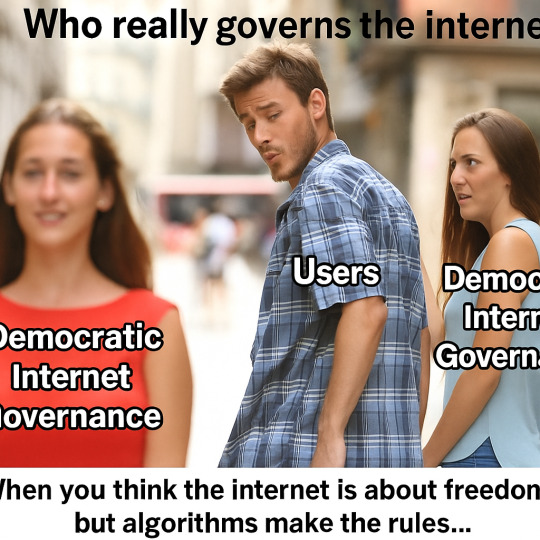#CSR RULES 2021
Explore tagged Tumblr posts
Text
Week 11: Digital Citizenship and Conflict: Social Media Governance

Digital citizenship is more than using technology responsibly. It includes active, informed participation in digital society and the negotiation of power and identity online. While it’s often portrayed as empowering and inclusive, it can also reflect existing inequalities and exclusions (Mossberger et al., 2008).

Governance in the Digital Age
Social media governance operates on multiple levels. At the macro level, national laws (like Australia's Online Safety Act 2021) and international regulations shape digital environments. At the micro level, moderators of Facebook Groups or subreddits set rules for their communities. These governance structures are often fragmented, with competing interests from governments, corporations, and users (Crowther & Rayman-Bacchus, 2016).

This UNFPA Malaysia cartoon illustrates online gender-based harassment, showing a woman attacked by monstrous male figures emerging from a computer screen. It critiques societal victim-blaming and the normalization of abusive male behavior online. “Jaga la diri… kau tu perempuan!” (“Take care of yourself… you’re a woman!”), while another says, “Biasa la, lelaki memang macam ni…” (“It’s normal, men are just like that…”).
Online Harassment: Forms and Impact
Online harassment includes name-calling, threats, doxing, and image-based abuse. It is often coordinated and systemic, especially against women, LGBTQ+ individuals, and people of colour (Marwick & Caplan, 2018). Research shows that more than half of girls worldwide have faced abuse online , and that cyberhate mirrors offline prejudices (Gardiner et al., 2016).

The Power Dynamics Behind Conflict
Digital conflict isn't just about individual bad actors, it reflects broader struggles over speech, identity, and control. Campaigns like Gamergate exemplify how online abuse is weaponized for political and ideological purposes, reinforcing the need to address power structures within digital platforms (Marwick & Caplan, 2018).
Responses to Online Harassment
Legal: The Online Safety Act 2021 mandates takedowns of harmful content within 24 hours.
Social & Cultural: Humour and satire, such as the work of Hannah Gadsby, can resist abuse.
Advocacy: Organisations like the eSafety Commissioner offer reporting tools and guidance.
Corporate Pressure: Public criticism has pushed platforms to improve moderation. A 2021 Pew study found that 79% of users felt social media companies were failing to address harassment.

Corporate Social Responsibility and Influencer Support
Brands are increasingly expected to protect influencers and users from abuse. CSR in the digital age means standing up for creators, offering support, and promoting positive community standards (Littleton, 2021). Companies must recognize their role in enabling or mitigating digital harm.
Conclusion
Digital citizenship today must include a deep understanding of online conflict, governance, and identity. It's about ensuring that participation in digital spaces is safe, inclusive, and equitable—not just accessible. Legal tools, community action, and corporate responsibility must work together to realise this vision.
References
Crowther, D. & Rayman-Bacchus, L., 2016. Corporate Social Responsibility. 3rd ed. London: Routledge.
Gardiner, B. et al., 2016. The dark side of Guardian comments. The Guardian. Available at: https://www.theguardian.com/technology/2016/apr/12/the-dark-side-of-guardian-comments [Accessed 17 May 2025].
Haslop, C., O’Rourke, S. & Southern, R., 2021. Online harassment and gender. Media, Culture & Society, 43(2), pp. 313–328.
Marwick, A. & Caplan, R., 2018. Drinking male tears: Language, the manosphere, and networked harassment. Feminist Media Studies, 18(4), pp.543–559.
Mossberger, K., Tolbert, C.J. & McNeal, R.S., 2008. Digital Citizenship: The Internet, Society, and Participation. Cambridge, MA: MIT Press.
Plan International, 2020. Free to be online? Girls and young women’s experiences of online harassment. Available at: https://plan-international.org/publications/freetobeonline [Accessed 17 May 2025].
#mda20009#self governance#cyberbullying#harrasment#digital communities#digital citizenship#governance
0 notes
Text
A Complete Guide to CSR-1 Registration for CSR Funding in India

Corporate Social Responsibility (CSR) in India has evolved from a voluntary activity into a structured, regulated obligation for certain companies. Under the framework of the Companies Act, 2013 and the associated CSR Rules, a key requirement for organizations intending to receive CSR funds is the mandatory registration through Form CSR-1. This blog serves as a detailed guide to understanding who needs to apply, why it’s essential, the legal framework, procedural details, documentation, and practical challenges in obtaining CSR-1 registration.
Why CSR-1 Registration Is Crucial
Historically, companies had often reported difficulties in ascertaining track record and capacity of an implementation agency (AI)/NPO, to undertake CSR activities to their satisfaction. In order to aid companies, the government introduced the idea of registration of IAs with the Ministry of Corporate Affairs (MCA) so that there emerges an authentic and reliable list of implementation partners for companies to select from. Thus, to bring transparency and accountability, the MCA made it mandatory for all implementing agencies to register with the Central Government by filing Form CSR-1.
This step ensures that only verified entities receive CSR funds from eligible companies.
Without this registration, entities are not permitted to receive CSR funds from any company, regardless of their prior experience or track record. Hence, Form CSR-1 acts as a gate-keeping mechanism to prevent misuse and to streamline fund disbursal.
Legal Framework Governing CSR-1 Registration
The requirement for CSR-1 registration stems from the following:
Section 135 of the Companies Act, 2013 – This section mandates eligible companies to spend a portion of their profits on CSR activities.
Rule 4(1) and Rule 4(2) of the Companies (Corporate Social Responsibility Policy) Amendment Rules, 2021 – These rules specify that entities intending to carry out CSR activities must register with the Central Government via eForm CSR-1, effective from April 1, 2021.
Who Needs to Apply for CSR-1 Registration
CSR-1 registration is mandatory for the following entities wishing to act as implementing agencies for CSR activities:
Section 8 Companies (not-for-profit companies registered under the Companies Act)
Registered Public Trusts
Registered Societies
Any entity established under an Act of Parliament or a State legislature
Out of the above, section 8 Companies/registered trusts/ registered societies (except the ones set by established by Central or State Government) should be registered under section 12A or sub clause (iv), (v),(vi) or (via) of section 10(23C) and section 80G of the Income-tax Act, 1961. Further, all entities must have valid PAN.
Contents of Form CSR-1
Form CSR-1 is a simple electronic form, but it requires precision. Key details to be filled include:
Nature of the entity
Date of registration/incorporation
PAN of the entity
Details of registration under relevant Acts (Trust Act, Societies Registration Act, Companies Act)
Names and details of Board Members/Trustees
DSC (Digital Signature Certificate) of the authorized person
Certification by a practising professional (Chartered Accountant, Company Secretary, or Cost Accountant)
Documents Required for CSR-1
To file the CSR-1 Form, the following documents are generally needed:
PAN Card of the entity
Registration Certificate (under applicable law)
Details of Governing Body Members
Digital Signature Certificate (DSC) of the authorized representative
Professional certification by a practicing CA, CS, or CMA
Process of Filing CSR-1
Preparation of Documents: Ensure all statutory documents are updated and ready.
Login to MCA Portal: Access the Ministry of Corporate Affairs website.
Download CSR-1 eForm: Available under eForms section.
Fill in Details: Carefully enter all required information as discussed above.
Attach Documents and Sign: Upload the supporting documents and affix DSC.
Professional Certification: The form must be certified by a practicing professional.
Submission: Submit the form through the MCA portal.
Once submitted, the MCA verifies the information. Upon successful verification, a unique CSR Registration Number is issued.
Allotment of CSR Registration Number & Its Importance
After successful filing and approval of Form CSR-1, the MCA allots a unique CSR Registration Number to the organization. This number:
Acts as an identifier for the implementing agency
Must be quoted by companies when reporting CSR expenditures
Is essential for tracking fund utilization and CSR reporting in annual reporting
This number essentially legitimizes the agency’s capacity to receive and execute CSR-funded projects.
Common Challenges in CSR-1 Registration and How to Overcome Them
While the process seems straightforward, entities may face certain hurdles:
Document Readiness: Incomplete or outdated documents can lead to rejection.
Digital Signature Issues: Ensure the DSC is valid and properly installed.
Lack of Professional Assistance: Errors in the form or certification may delay approval. It is advisable to consult an experienced professional for form preparation and certification.
Understanding MCA Portal: The portal can be technical for first-timers. Training staff or using consultants can help navigate the process smoothly.
How Can ThinkCap Advisors Help
Often, implementing agencies apply for CSR registration number without understanding the requirements of CSR law. CSR regulations impose certain restrictions on acceptance of funds by Implementing agencies. Since the allotment of CSR registration number is automatic, IAs often apply and receive without understanding their eligibility to receive funds under CSR regulations. Simply put, having a CSR registration number does not automatically allow a non-profit to receive funds. At ThinkCap, as a CSR consulting firm, we provide strategic guidance to non-profits to help them understand the nuances of CSR law so that they become eligible to receive CSR funds.
Conclusion
CSR-1 registration is more than a regulatory formality—it is a validation of an organization’s legitimacy, and readiness to partner with corporates in creating social impact. With increasing scrutiny and evolving CSR norms, having a CSR Registration Number is now indispensable for IAs in India.
As a CSR consulting services & social sector consulting firm, we advise clients to be meticulous with documentation, understand the legal framework, and seek the right professional support to ease the process and open doors to substantial funding opportunities. In an era where corporate goodwill is deeply tied to social contribution, CSR-1 registration is your non-profit’s ticket to meaningful collaborations and sustained impact.
Tag = CSR ADVISORY SERVICES, CSR CONSULTING, CSR CONSULTING SERVICES
0 notes
Text
Digital Citizenship in the Age of Conflict: Lessons from Social Media and Sulli Choi's Legacy

Conflict on social media has become a commonplace aspect of our online lives in the digital era. As digital citizens, we must address problems like trolling, flaming, and harassment while also promoting civil communication. The social media environment is shaped by several practices, which frequently have detrimental effects on mental health: trolling (planned provocation), flame (hostile exchanges), and harassment (continuous targeting of people). Gender gap in online harassment emphasizing how women are disproportionately affected (Haslop, C., O’Rourke, F. and Southern, R., 2021). This is a problem that social media administration needs to solve.

In the context of social media, governance refers to the rules and guidelines that platforms put in place to stop harmful conduct. Corporate social responsibility (CSR), regulatory reforms, and platform pressure are essential tactics to deal with these problems (Thompson, 2023). Advocacy organizations have called for more implementation of anti-harassment regulations because, although some platforms have taken positive steps, such as banning obnoxious users, the measures sometimes fall short.

While satire and humor might occasionally deter harassers, the impacts of constant harassment were severe for manyWhile satire and humor might occasionally deter harassers (Vitis, L. and Gilmour, F., 2016), the impacts of constant harassment were severe for many, including K-pop sensation Sulli Choi. Sulli, a vocal supporter of women's rights and mental health in South Korea, was subjected to a barrage of cyberbullying, which finally led to her untimely death in 2019. Her situation brought attention to the shortcomings of current safeguards and sparked a public clamor for further platform responsibility and regulation (Gleeson, 2018).
In addition to more robust legal frameworks and platform responsibility, future digital citizenship initiatives should incorporate instruction on empathy, responsible engagement, and advocacy against abuse. We want to make online spaces genuinely inclusive and secure for everyone by creating a safer online environment in remembrance of those like Sulli who have experienced the worst aspects of digital life.
REFERENCES
Haslop, C., O’Rourke, F. and Southern, R. (2021). #NoSnowflakes: The toleration of harassment and an emergent gender-related digital divide, in a UK student online culture. Convergence: The International Journal of Research into New Media Technologies, 27(5), pp.1418–1438. doi:https://doi.org/10.1177/1354856521989270.
Thompson, J.D.T. (2023). New journalism research will help mitigate the harms of online hostility. [online] Freilich Project for the Study of Bigotry. Available at: https://freilich.anu.edu.au/news-events/blog/new-journalism-research-will-help-mitigate-harms-online-hostility.
Vitis, L. and Gilmour, F. (2016). Dick pics on blast: A woman’s resistance to online sexual harassment using humour, art and Instagram. Crime, Media, Culture: An International Journal, 13(3), pp.335–355. doi:https://doi.org/10.1177/1741659016652445.
Gleeson, J. (2018). Explainer: what does ‘gaslighting’ mean? [online] The Conversation. Available at: https://theconversation.com/explainer-what-does-gaslighting-mean-107888.
1 note
·
View note
Text
What is the importance of CSR-1 registration?
The Ministry of Corporate Affairs has made the CSR-1 form available on its internet and requires all social organizations requesting CSR funds or functioning as csr registration implementing agency to file it. According to the Ministry of Corporate Affairs' notice, CSR money will be made available exclusively to NGOs that have registered with MCA by filing Form CSR-1 beginning April 1, 2021.
The provisions of the 2019 Amendment to the Companies Act, 2013, concerning Corporate Social Responsibility (CSR) came into force on January 22. According to the new provisions, every entity covered under sub-rule (1) that intends to undertake any CSR activity will have to register with the Central Government by filing Form CSR-1 electronically with the Registrar of Companies with effect from April 1, 2021. These provisions shall not affect the CSR projects or programs.
The system will produce a unique CSR Registration Number automatically after you submit Form CSR-1 on the MCA portal. The MCA thus maintains a list of all implementing entities, enhancing the likelihood of planned actions being completed on time. Companies might refer to the historical performance records of implementing agencies to assist them decide whether to engage in future CSR efforts.
0 notes
Text
Online Registration for Section 8 Companies

Non-Governmental Organizations (NGOs) in India have the option to register as a trust under the Trust Act 1882, a society under the Societies Act 1860, or as a Section 8 company under the Companies Act 2013. Opting for Section 8 company registration involves the process of incorporating an NGO, providing the flexibility to engage in activities promoting Art, Commerce, Science, Technology, Sports, Education, Social Welfare, Social Research, Religion, Charity, and Environmental Protection, among others. Once registered, a Section 8 Company has the liberty to operate anywhere in India.
Understanding Section 8 Companies
Considered an upgraded form of registration, Section 8 companies offer numerous advantages for charitable institutions compared to societies and trusts. It has become the preferred choice for NGO registration due to its streamlined registration process, operational ease, and efficient management. The primary objective of a Section 8 company is to advance non-profit causes, spanning various areas such as commerce, art, science, sports, education, research, social welfare, religion, charity, and environmental protection.
Mandatory CSR Registration for NGOs
Since April 1, 2021, NGOs are required to file Form CSR-1 on the Ministry of Corporate Affairs (MCA) portal to register with the Central Government. This initiative enhances the monitoring of Corporate Social Responsibility (CSR) expenditures across the country. The CSR-1 Form, available on the MCA website, is now a mandatory requirement for social organizations seeking CSR funds or acting as CSR implementing agencies.
Documents Required for Section 8 Company Registration
To initiate Section 8 company registration, the following documents need to be submitted:
PAN Card of all directors and shareholders
Aadhaar Card of all directors and shareholders
Recent Bank Statement of all directors and shareholders
Phone Bill or Electricity Bill of all directors and shareholders
Voter ID, Passport, or Driving License of all directors and shareholders
Passport size photo of all directors and shareholders
Rental agreement copy if the registered office is rented.
Registration Process for Section 8 Companies
The process of registering a Section 8 company involves the following steps:
Obtain a Digital Signature Certificate (DSC).
File Section 8 Incorporation Forms on the MCA Portal.
Upon regional director approval, submit the Section 8 company registration application and necessary documents on the MCA portal.
Provide required clarifications to the Registrar of Companies (ROC) during the process.
Upon satisfactory submission, the ROC issues a Certificate of Incorporation and a distinctive Company Identification Number (CIN).
Submission of Memorandum of Association (MoA) and Articles of Association (AoA) follows the issuance of the license. Before completing the registration, ensure the acquisition of Permanent Account Number (PAN), Tax Deduction and Collection Account Number (TAN), and a bank account for the company.
Requirements and Compliances for Section 8 Company Registration
Section 8 companies must adhere to certain requirements and compliances:
Minimum of two directors and two members for incorporation.
No minimum share capital requirement.
Charitable objectives and prohibition of profit distribution among members.
Governance by a Board of Directors, as specified in the MoA and AoA.
Compliance with rules and regulations under the Companies Act 2013.
Adherence to the provisions of the Income Tax Act.
GST registration if goods and services exceed the prescribed turnover limit.
Registration Fees for Section 8 Companies
The approximate registration fees for Section 8 companies in India are as follows:
DSC & DIN: Around Rs. 3,000
Company Name Reservation: Approximately Rs. 1,000
MoA, AoA, Government, and Incorporation fees: Rs. 6,000-8,000*
Notary and Stamps: Approximately Rs. 2,000
Professional Fees: Rs. 8,000-10,000*
Note: Figures are approximate and subject to variation based on various factors.
Benefits of Section 8 Company Registration
Section 8 companies offer various benefits, including:
No minimum capital requirement.
Eligibility for tax benefits under the Income Tax Act.
No stamp duty on incorporation.
Separate legal identity for the company.
Enhanced credibility due to strict compliance requirements and mandatory annual audits.
Exemption for donors under Section 80G for tax benefits.
Annual Compliances for Section 8 Companies
Section 8 companies are required to fulfill annual compliances, including:
Minimum of two board meetings annually.
Maintenance of proper books of accounts.
Preparation of annual financial statements, including the balance sheet, profit and loss account, and cash flow statement.
Mandatory annual audit of financial statements.
Conducting an annual general body meeting within six months of the financial year-end.
Income tax return filing and filing of financial statements with the ROC using Form AOC-4.
Filing of an annual return in Form MGT-7, providing information about directors, shareholders, and other key details.
Fulfillment of additional compliances based on specific registrations, such as obtaining 12AA registration for tax exemption or 80G registration for donor tax benefits.
0 notes
Link
#CSR POLICY#AMENDMENT RULES 2021#csr AMENDMENT RULES 2021#The4thwheel#CSR COMPANIES#Corporate Social Responsibility Policy#CSR POLICY 2021#CSR RULES 2021
0 notes
Link
Every year, I look for important themes in sustainability that will have lasting impact on society, from glaring evidence of global megatrends to inspiring stories of corporate action. The year 2018 brought extreme change — in weather and environmental ecosystems, in political winds and power, and in the expectations of business. It also brought incredible clarity about the scale of our challenges and opportunities.
So let’s start with the big picture before moving to some corporate success stories.
The world’s scientists sound a final alarm on climate
We have about 12 years left. That’s the clear message from a monumental studyfrom the Intergovernmental Panel on Climate Change (IPCC). To avoid some of the most devastating impacts of climate change, the world must slash carbon emissions by 45% by 2030, and completely decarbonize by 2050 (while, in the meantime, emissions are still rising).
The IPCC looked at the difference between the world “only” warming two degrees Celsius (3.8°F) — the agreed upon goal at global climate summits in Copenhagen and Paris — or holding warming to just 1.5 degrees. Even the latter, they say, will require a monumental effort “unprecedented in terms of scale.” We face serious problems either way, but every half degree matters a great deal in human, planetary, and economic losses.
It wasn’t just the IPCC that told a stark story. Thirteen U.S. government agencies issued the U.S. National Climate Assessment, which concluded that climate change could knock at least 10% off of GDP. Other studies tell us that sea level rise is going to be worse than we thought, Antarctica is melting three times faster than a decade ago, and Greenland is losing ice quickly as well. If both those ice sheets go, sea level rise could reach 200-plus feet, resulting in utter devastation, including the loss of the entire Atlantic seaboard (Boston, New York, D.C., etc.), all of Florida, London, Stockholm, Denmark, Uruguay and Paraguay, and land now inhabited by more than 1 billion Asians.
All of this suggests that business must dramatically change how it operates: companies will need to push well past their comfort zones from areas like politics and policy to engaging consumers to how they make investment decisions.
Entire towns are wiped off the map by extreme weather
This year the weather devastation around the world got, in the words of one colleague, “biblical.” The town of Paradise, California, was effectively eliminated by wildfires (that, yes, are made worse by climate change), killing at least 85 people. Most houses in Mexico Beach, Florida, were destroyed by Hurricane Michael. Unprecedented rains and damage from Hurricane Florence slammed North Carolina and temporarily turned a major highway into a river. Typhoon Mangkhut ravagedthe Philippines and parts of China, killing dozens of people. Incredible heat blanketed four continents this summer, with records falling across Europe and Asia. Venezuela’s last glacier is disappearing. Finally, Capetown, South Africa, is essentially out of water due in part to drought — the city nearly shut off all the taps this year, but has held off “Day Zero” through ongoing restrictions and aggressive citizen action.
The consequences of these extremes are not theoretical. What is the economic cost to an area with no water, or one that’s under water, or burned to the ground? In the U.S. alone, it was $306 billion in 2017, shattering records.
Coral is dying, insects are disappearing, and the fate of major ecosystems looks dim
The world’s top coral expert confirms that at 2 degrees of warming, all coral will die. This will destroy a critical part of an ocean system that provides protein to hundreds of millions of people, helps blunt coastal storm surges, and supports the livelihoods of people working in fishing and tourism.
And it’s not just coral: there’s the death of pacific kelp forests, radical declines in insect populations, and continuing population drops in all mammals and bees.
How does this all connect to business? For some sectors, it’s obvious: the food and agriculture industry will have trouble feeding us without pollinators, and tourism takes a big hit without coral and other wildlife. But more broadly, society will not thrive in a world where entire pillars of planetary support are collapsing. And if society can’t thrive, neither can business.
The U.S. environmental protection system continues being dismantled … from within
The EPA and Department of Interior are reversing years of protections for air, water, and land. In 2018, the Trump administration has opened up offshore waters and rolled back safety rules for drilling, greatly weakened the voice of science in policy, reduced focus on children’s health, and moved to make it easier to build dirty coal plants.
The big question now is whether businesses will push back and go down a cleaner path on their own. It’s easy to see why multinationals might as they face pressure from sub-national regions — California Gov. Jerry Brown held a Global Climate Action Summit which produced many aggressive climate goals from cities and state, for example. Gov. Brown also signed aggressive new laws committing to carbon-free electricity statewide by 2045 and requiring solar on all new homes. So even if U.S. action sputters, governors and mayors who influence local and regional business conditions will be pushing the clean economy and pro-climate agendas.
In pointed contrast to the U.S., the EU backed a proposal to strike no new trade deals with countries not in the Paris climate accord (i.e., only the U.S.), France will shut coal plants by 2021, India just cancelled plans for big coal plants, and China banned 500 inefficient models of cars.
A prominent leader retires, but new leaders step up
For nearly a decade, no business leader has done more to bring sustainability into the business mainstream than Paul Polman, Unilever’s outgoing CEO (Full disclosure: I’ve worked with Unilever). His depth of understanding of our biggest global, social, and environmental challenges, and his commitment to use business as a way to tackle them, has been unparalleled. But it wasn’t just talk. The company also grew throughout Polman’s tenure and the stock outperformed peers and the FTSE index. Luckily, there are other corporate leaders who are stepping up, including Danone’s Emmanuel Faber (see below for more).
But climate isn’t the only area where we’re seeing bold stances. Societal issues more broadly made headlines, too. The New York Times declared 2018 year that “CEO activism has become the new normal,” with prominent voices like Salesforce’s Marc Benioff leading the way. Other notable moments include Nike making Colin Kaepernick — the man who led NFL player protests about police violence against African Americans — the face of its 30th anniversary “Just Do It” campaign (sales rose quickly). Under pressure from survivors of school mass shootings, Dick’s Sporting Goods stopped selling assault weapons, and other companies cut ties to the powerful National Rifle Association. Kroger celebrated a year of its “End Hunger” initiative. Unilever threatened to pull its substantial ad dollars from Facebook and Google if they didn’t police “fake news and toxic content.” One hundred U.S. CEOs urged action on controversial immigration issues. And more than 100 U.S. companies gave employees time off to vote.
Danone North America becomes the world’s largest B Corporation
A “B Corp” certification requires answering an intensive set of questions on environmental, social, and governance issues. But most importantly, it commits a company to create value for all stakeholders (customers, employees, communities, and so on), not just shareholders.
French consumer products giant Danone has now put 30% of its brands and businesses through the certification process and says that “companies are fundamentally challenged as to whose interests they really serve.” Becoming a B Corp is arguably is a direct statement about whose interests it values most, and it’s and fascinating frontal attack on the dominance of shareholder capitalism.
More investors are viewing climate and sustainability as core value issues
Something is shifting in finance. Vanguard wants CEOs to be a force for good. Mark Carney, Governor of the Bank of England, said that “70% of [UK] banks, who normally have a shorter horizon, are viewing climate as a financial risk—not a CSR one.” Larry Fink, CEO of Blackrock, the world’s largest asset owner, encouraged longer-term thinking about environmental, social, and governance issues in a strongly-worded letter to large-company CEOs.
Anecdotally, I’ve talked to leaders at big banks who are now thinking differently about purpose and systemic risk. And in a quieter move, a major real estate investor in Miami began pulling money out of coastal assets to avoid risk of sea level rise. Watch this space.
The clean technology explosion continues and accelerates
Three big clean tech themes wowed me this year.
1) Renewables keep getting cheaper. According to Lazard’s annual analysis of the cost of building new power plants, renewables are now the cheapest. And another global analysis showed that new wind and solar are cheaper than one-third of the coal already on the grid — and will be cheaper than 96% of existing plants by 2030.
2) Corporate buying of clean energy keeps rising. By the end of just the first half of 2018, businesses bought more clean energy than they did in 2017. Companies like Owens Corning (disclosure: a client of mine) are buying enough green energy to pitch their products as cleanly manufactured (which they started doing in late 2017).
3) Electric vehicle sales are exploding, and it’s not just small vehicles: even container ships are going electric. UPS bought its first EV delivery vehicles at price parity to combustion engines, and China is adding nearly 10,000 electric buses to the roads — equal to the size of London’s entire bus fleet – every five weeks.
China rejects the world’s trash
For years, the U.S. had a great deal: When container ships arrived from China with goods, we sent them back filled with our recyclable paper and glass. But starting January 1, 2018, China stopped accepting our trash. The ripples of this move are unpredictable and still moving through the system, but in some regions, materials piled up and prices for recycled content plummeted. In a business world trying to go “circular” (i.e., find a use for everything and eliminate waste), it was a wake-up call about how much waste we still produce.
The battle against single-use plastic heats up, starting (somewhat oddly) with straws
Sometimes weird things hit a tipping point. For a combination of reasons, including a viral video showing a turtle with a straw stuck in its nose, companies waged war on straws this year. Marriott, McDonald’s, Starbucks, Burger King, and the city of Seattle, among others, all banned or are phasing out straws. It was a very small part of a larger conversation about “single-use plastics,” most notably plastic bags, which IKEA and Taiwan are banning as well.
Raising the bar for suppliers
The greening of the supply chain is a perennial story, but there are some noteworthy recent actions. Apple created a $300 million fund to help suppliers in China build more solar, and also partnered with Alcoa and Rio Tinto to develop a better smelting process to make carbon-free aluminum. On the labor side of the supply chain equation, PepsiCo and Nestle cut ties with a palm oil supplier over human rights abuses and Coca-Cola said it would work with the U.S. State Department to use blockchain to fight forced labor.
Meatless options grow plentiful
Given the way most cattle is currently raised, one of the most effective things an individual can do to reduce her carbon footprint is eat less meat. The options to do so are growing, and the rise of products made from non-animal proteins has been remarkable. The Impossible Burger, Beyond Meat, and other brands have made believers out of skeptics (they taste great) and are, as the Wall Street Journal put it, “overrunning grocery meat cases.” In another fascinating move, tech company WeWork went meat-free in its offices and even stopped reimbursing employees on business trips for meat meals.
What comes next…
I’m sure I missed many stories, especially globally (my view is from the U.S.). Predictions are hard, but I’m safe in assuming 2019 will be a bumpy ride again. Ultimately, today’s global political situation is, at best, unpredictable. Brazil now has a strongman-style leader who talks about cutting down the Amazon, but the U.S. just swung its House of Representatives back the other way, giving power to Democrats who want more focus on climate change, inequality, and other sustainability agenda items. No matter what happens politically, it seems clear that companies will continue to feel pressure, internally and externally, to do more on social and environmental issues. While the problems face we are extremely serious, I remain optimistic that companies will be doing more in 2019 than ever before.

46 notes
·
View notes
Text

Southwire Sustainability Report 2021: Water and Wastewater
Southwire Sustainability Report – Through water quality and quantity rules, as well as regulatory compliance, Southwire manages water resources responsibly. In industrial and mill locations with high water use processes, such as contact and non-contact cooling, we focus operational water use.
0 notes
Text
MCA further extends due date for filing CSR-2 for F.Y. 2020-21 till 30th June 2022
MCA further extends due date for filing CSR-2 for F.Y. 2020-21 till 30th June 2022
MCA has notified the Companies (Accounts) Third Amendment Rules, 2022. As per the amended rules, the CSR-2 for Financial Year 2020-21 can be filed till 30th June, 2022. Earlier the MCA had provided the extension till 31st May, 2022. Further, Form CSR-2 shall be filed separately for F.Y. 2021-22 on or before 31st March, 2023 after filing Form AOC-4 /AOC-4 XBRL or AOC-4 NBFC (Ind AS), as the case…
View On WordPress
0 notes
Text
From Compliance to Impact: Understanding Impact Assessment of CSR
The Companies (Corporate Social Responsibility Policy) Amendment Rules, 2021, have made impact assessments a mandatory component of CSR reporting, integrating them into annual reports alongside financial disclosures. This positions impact assessment as a key measure of corporate accountability.
To know more, visit: https://www.thinkcapadvisors.com/csr-advisory-and-structuring
#CSR#csrconsulting#csrindia#indiacsr#corporatesocialresponsibility#csrimpact#impactassessment#csrconsultingfirm#csrconsultingservices#csradvisoryservices
0 notes
Link
In January 2021, the Ministry of Corporate Affairs made amendments to CSR rules of 2014 and made impact assessment compulsory for companies that undertake CSR expenditure and CSR activities, over a specific threshold. This amendment aims at creating accurate parameters to assess the impact of CSR activities.
0 notes
Text
Licensing and Compliance Developments for Pharmacy Benefit Managers
In response to calls for more transparency in the prescription drug industry, 2021 continued a national trend of increased state licensing and regulation of Pharmacy Benefit Managers (“PBMs”). Over the past year, laws requiring PBMs to obtain PBM, Third Party Administrator ("TPA") or Healthcare Benefits Administrator ("HCBM") licenses/registrations from State regulations have been adopted or entered into force in at least eighteen states. In addition to new licensing requirements, many states have also adopted requirements that regulate other aspects of PBM operations.
New PBM License and Registration Requirements
The eighteen states that adopted a PBM license/registration requirement (or came into force) in 2021 include:
Alabama – SB 227 (effective 07/01/2021)
Alabama - Rule and Regulation 482-1-164-.01 (effective 01/01/2022)
Delaware – HB 219 (effective 10/26/2021)
Georgia - Rule and Regulation 120-2-97-.01 (effective 01/01/2021)
Hawaii – SB 1096 (effective 06/28/2021)
Indiana - HB 1405 (effective 04/29/2021)
Kentucky - Rules and Regulations 806 KAR 9:360 (Amendment effective 06/07/2021)
Maine - Rules and Regulations Chapter 210 (effective 2021-02-14)
Maryland – HB 601 (effective 01/01/2022)
Maryland – Bulletin 21-07 (effective 04/03/2021)
Minnesota: Insurance Code 62W.11 (amendment effective 07/01/2021)
Mississippi – Rules and Regulations R30-3001-4501 (Amendment effective 12/30/2021)
Missouri - Rule and Regulation 20 CSR 200-22.010 (effective 10/30/2021)
Montana – SB 395 (effective 01/01/2022)
Montana - Rules and Regulations October 12, 2021 (effective 12/10/2021)
New Hampshire – Bulletin 21-001-AB (effective 04/01/2021)
New Hampshire – Bulletin 21-104-AB (effective 12/17/2021)
New Mexico - Rules and Regulations 13.10.30.9 (effective 03/01/2021)
North Carolina – SB 257 (effective 2021-01-10)
Oklahoma – HB 2677 (effective 05/04/2021)
South Carolina – Bulletin 2021-08 (effective 12/01/2021)
Washington – Insurance Code 48.200.010 (effective 01/01/2022)
Washington – Rules and Regulations 284-180-110 (effective 01/01/2022)
All of the above states prohibit an entity from acting as a PBM without first obtaining a license or registering with the appropriate public authority (e.g., state insurance department, board state pharmacy, etc.). Specific license or registration application requirements vary by state. However, applications often require the submission of the following documents and information:
Organizational information about the applying entity, including documents such as articles of incorporation and applicant's articles of association
A certificate of good conduct (or its equivalent) from the state of the applicant's domicile and the state in which the applicant is applying for a license
The professional qualifications of the candidate's principals
General information about the requesting entity and some of its directors regarding criminal records, regulatory actions, financial matters and civil litigation
Financial statements showing that the applicant is financially good
A deposit and/or proof of certain insurance coverage
A detailed business plan
Form contracts with payers and/or pharmacies
New operational requirements
In addition to the new licensing and registration requirements mentioned above, many states have also recently adopted requirements that regulate certain aspects of PBM operations. Common operational issues addressed by these new requirements include:
Prohibited clauses and mandatory provisions in agreements between PBM and its payers and/or contracted pharmacies
Minimum Standards and Restrictions on the Use of Maximum Allowable Cost ("MAC") Pricing
A pharmacy's right to appeal a claim determination and a PBM's right to change a prior claim determination
Pharmacy Network Suitability Standards and Network Participation Eligibility
Pharmacy Audit Rights and Protections
Due to the recent significant increase in the number of states that now license and regulate PBMs, it is important that PBMs confirm that they meet licensing/registration requirements and operational needs of the States in which they are active.
0 notes
Text
Next.js 採用プロダクトにおける Lint ツール導入事例
mediba Advent Calendar 2021 の 18 日目の記事です。
こんにちは。エンジニアの中畑(@yn2011)です。最近は Switch の月姫で直死の魔眼について学んでいます。
初めに
プロダクトを新規に開発する際に、どんな Lint ツールを導入し、どのような設定で利用するかは悩むことが多いです。最終的にはチームメンバーと議論をして決めていく必要がありますが、社内外の他のプロダクトでどのようにしているか参考事例が欲しい場合があります。業務で開発したプロダクトのコードベースは社外に公開されることは少ないため、他社でどのような Lint ツールを導入しているのかを知る機会は少ないです。
��ういった背景から、直近のプロダクト開発において ① どんな Lint ツールを導入しているか、② 特に工夫している設定は何か、という Lint にフォーカスした内容を書いたらどうだろうと考え、今回の記事のテーマとしました。
昨年から引き続き、mediba のプロダクトでは Next.js の採用が増えています。そ��中のとある Next.js 採用プロダクトを例として今回ご紹介します。
tsc
TypeScript です。Next.js 9 以降は、TypeScript 関連の機能はビルトインされていて yarn build 時に型検査を行いますが、型検査だけを任意のタイミングで行う場合は、tsc -p . --noEmit のようなコマンドを実行します。Lint ツールではありませんが、型検査のためにだけ使用しているので一応記載しました。
ESLint
ESLint です。Next.js 11 以降は、ESLint 関連の設定をビルトインするようになり、next lint で実行と設定ができます。
Next.js 向けのコンフィグとして、eslint-config-next があります。以下のルールはオフにしています。
"@next/next/no-img-element": "off", "@next/next/no-html-link-for-pages": "off", "@next/next/next-script-for-ga": "off", "@next/next/no-sync-scripts": "off",
Next.js の機能を活用するためのルールをなぜオフにしているか疑問に思われるかもしれませんので理由を説明します。
no-img-element は、Next.js が提供する next/image を使用せずに、img 要素を使用している場合に警告を行うルールです。プロダクトでは、SSR ではなく、SSG を使用していて next/image は未使用なのでオフにしています。
no-html-link-for-pages は、Next.js が提供する next/link を使用せずに anchor 要素のみを使ってリンクを実装している場合に警告を行うルールです。next/link を使用することで、CSR でページ遷移を実現することが可能になりますが、mediba で利用している Google Analytics 向けの実装ではページ遷移時の集計に懸念があることが分かっています。そういった理由から意図的に next/link を使用しないようにしているため、ルールをオフにしています。
next-script-for-ga と no-sync-scripts は、next/script の仕様をきちんと調査できていなかったので暫定的に script 要素を使用していましたが今後対応するかもしれません。
Stylelint
Stylelint です。プロダクトでは、styled-components のような JS in CSS ではなく、.scss ファイルに定義した CSS を CSS Modules から利用しているためプロパティの並び順の auto fix 等、Stylelint の機能を全て活用することができています。
プロパティの並び順定義は、stylelint-config-recess-order を使用しています。定義されているプロパティの数とメンテナンスの頻度の面で、他のライブラリや自身で作成するよりも良さそうだったため選定しました。
また、Prettier を使用しているので stylelint-config-prettier で競合を防いでいます。
markuplint
markuplint です。HTML Living Standard の仕様に準拠した HTML になっているかを検証できます。React (JSX) にも対応しています。
ルールを独自に追加しています。
{ "nodeRules": [ { "selector": "meta[property]", "rules": { "invalid-attr": { "option": { "attrs": { "property": { "type": "String" }, "content": { "type": "String" } } } } } } ] }
meta 要素の属性についてです。SNS でページを共有された際の挙動を定義するため、このような meta 要素を実装することが多いと思います。
<meta content="ページタイトル">
この実装は markuplint が 2 つ警告を出します。まず、HTML Living Standard の meta 要素の仕様には、property 属性が定義されていないため警告を出します。 また、name 属性が定義されていない場合に、content 属性を使用することができないため、こちらについても警告を出します。
では一体この属性は何なんだ、という話になりますが、property 属性については RDFa で定義されており、OGP に従ってこの meta 要素を SNS 側が解釈します。したがってここでは例外として取り扱うようにルールを変更しています。
なお、React 独自の属性(key や dangerouslySetInnerHTML) は @markuplint/react-spec に含まれているため独自にルールを追加する必要はありません。便利です。
まとめ
直近の Next.js 採用プロダクトを例に、使用している Lint ツールと、その設定についてご紹介しました。これらの Lint ツールは全て GitHub Actions で commit push をトリガーにして実行していますので、ルールに違反しているコードをコミットするとすぐに気づくことができ、Lint ツール運用の形骸化を防ぐことができています。
Lint ツールの導入によって、コードベースをクリーンに保つことはもちろんですが、標準仕様やベストプラクティスを知る良いきっかけにもなっています。
Lint ツール導入時の参考になれば幸いです。最後までお読み頂きありがとうございました。
0 notes
Text
Emirates Amateur Golf League returns with two new events at Meydan


The popular Emirates Amateur Golf League is set to return better than ever with the announcement of two new events taking place at the Track, Medan Golf on Saturday December 18th.
The EAGL Corporate Invitational will see nine eight-person teams representing some of the region’s top businesses battle it out for top honours over the much-loved Peter Harebrained-designed 9-hole course. Already confirmed are Emirates NBD, Bentley Emirates, WoW (Wealth of Wellness), 24 Secure (international security firm), real estate developer Shapoorji Pallonji and Satoshi FX – a Forex & Crypto firmas well as an Emirati Players team sponsored by the Giant group as a part of their CSR and sports enhancement activity.
Priyaa Kumaria – League Administrator, commented: “The Corporate Invitational will be the first event of a planned Business Series and will feature nine teams represented by the banks, airlines, wellness, real-estate, logistics, Industry, luxury car and an EAGL Team. The agenda of the Corporate Invitational is to host eight different Corporates who shall further their customer / client enhancement via golf by fielding eight players each.
“The corporates shall reap intangible benefits which are valued much higher with this model as compared to a regular golf day where only existing clients are invited.”
One of the standout features of the Emirates Amateur Golf League, which hosted its first showcase event at Jumeirah Golf Estates back in June, is its commitment to giving amateurs a pro-golf-like experience. Central to this is the fact that the events are broadcast live on TV and online channels and EAGL Founder and Chairman Sudesh Aggarwal revealed that this key feature would again be at the forefront of the upcoming event at The Track, Meydan, Golf. “Live broadcast has been the mantra for EAGL and this is another first of its kind for amateur golf,” said Aggarwal. “The EAGL Corporate Invitational will be live on Dubai sports and on the EAGL YouTube channel. Another path breaking initiative by EAGL after the resounding success of the showcase event held in June 2021.
“The EAGL Business Series is for promoting business, networking and team golf and in the Corporate Invitational we have raised funds partly from team sponsorships while the event costs around USD 250k.
“This event being of commercial nature will accrue benefits to the participating corporates directly and indirectly in many ways especially with the Live TV broadcast.”
The golf event on Saturday December 18th will be preceded by a Gala Dinner at the glamorous Meydan Hotel on the evening of Thursday December 16th alongside a night at the races on the iconic track.
“We are very happy to host the event in an all-inclusive luxury destination venue like Meydan with golf, dinner and races and a lavish spread for our teams. Meydan will be decked to welcome our teams with personalized lockers, carts with caddies and the wonderful weather and ambience that Meydan offers,” added Kumaria.
The prize for winning the EAGL Corporate Invitational will be a team golfing holiday to the Lighthouse Golf & Spa Resort in Bulgaria while the winning corporate team sponsor will receive the much coveted EAGL bespoke trophy and a ½ page advert in a national newspaper.
The Track, Meydan Golf’s Director of Golf, William Bruce, said: “We are incredibly excited to host the Emirates Amateur Golf League at the Track, Meydan Golf. Meydan Golf has always prided itself on being the most inclusive golf experience in Dubai and partnerships like this one with the EAGL will help to further promote the facility as one that is available and open to all standards of golfer day or night, without the need for a membership, special dress code or stuffy rules!”
Taking place on the same day as the EAGL Corporate Invitational will be the inaugural EAGL Junior Championship hosted by Shiv Kapurwhich aims to serve one of EAGL’s key goals to grow the game of golf among the younger population in the UAE.
EAGL Ambassador, European Tour pro, Shiv Kapur, said: “The Business-Series will also have a junior series which will be a regular feature. I feel that a lot has been done at the corporate level and grassroots level but in terms of competition with juniors we thought it would be a great platform to give alongside the business angle to promote junior golf and the women’s game in the region. I think a lot happens in Dubai at professional level but at the amateur level this is probably the grandest event that you’re going to see in the amateur golf landscape in Dubai.”
https://www.satoshifx.com/
0 notes
Text
MCA introduces new Form CSR -2: A step towards more transparent CSR reporting
MCA introduces new Form CSR -2: A step towards more transparent CSR reporting
The Central Government has notified the Companies (Accounts) Amendment Rules, 2022. As per amended rules, every company covered under u/s 135 shall furnish a report on Corporate Social Responsibility in E-Form CSR-2 to the Registrar for the preceding financial year (2020-2021) and onwards. Earlier there was no form prescribed to furnish a report on CSR.The Central Government has notified the…
View On WordPress
0 notes
Text
Women entrepreneurship – A game changer for the Indian economy

American author Helen Keller once famously said, "Alone we can do so little, together we can do so much."
When these terms are considered as a part of the socio-economic development for communities that are vulnerable across low-income nations, they are the basis on which all interactions and collaborations are constructed. When diverse stakeholders with their particular skills and expertise collaborate to create a unifying vision while participating in constructive, organized dialogue, it can lead to actionable changes. Based on this concept that the collaborations of India's government with inter-sectoral partners, inter-sectoral collaborations, and corporate Social Responsibility (CSR) programs are constructed.
A review of the effectiveness of multi-stakeholder initiatives within the ecosystem of women entrepreneurs will show that even though organizations, philanthropic investment and companies have merged their resources to collaborate however there is still a lot to be accomplished. Access to government schemes such as MUDRA, Pradhan Mantri Rozgar Yojana, Startup India Programme, Skill India, Udhyam Sakhi Portal for Women Entrepreneurs, and the Women Entrepreneurship Platform by Niti Aayog, remains a huge concern due to lack of awareness or understanding of the benefits at the grassroots--especially for rural women entrepreneurs.
The 'Landscape study on women's Entrepreneurship' that was conducted by EdelGive Foundation as a part of our UdyamStree campaign it was revealed that only one percent of the women in the study were capable of leveraging government programs in their favor. The study also revealed that the majority of females (94 percent) made the decision to establish their own business after consulting their families, who tend to be the most influential stakeholders on an individual level. Without their help many women believed that their business could not succeed.
The lack of employment opportunities and the increasing domestic work has led to a steady decline in the number of women in India's work force. The pandemic has only exacerbated the social, economic and cultural barriers facing women. According to The World Economic Forum's Global Gender Gap Report 2021, India still ranks 140th out of 153 nations. Contribution that Indian women to GDP are 18 percent, which is lower than the average global figure of 37 percent. This is despite just fourteen percent of females deciding to pursue careers as entrepreneurs.
In addition, many women from semi-urban and rural India remain on the market for informal labor that offers them no security of employment or social protection since it is not governed by the rules of the laws of the country. Furthermore, because of the nature of the informal labour force and the exploitation that occurs there in a huge way. According to a report from the 'Initiative for what works to improve the status of women and girls in the Workplace', more than 91 percent women in India work in the informal industry, where their wages fluctuate. They don't have bargaining power and they are often working in poor conditions and are often consigned to the lowest levels of society through archaic patriarchal structures. In the scenario, women's entrepreneurship and leadership, as with many complicated development sector scenarios using multi-stakeholder intervention, which includes robust capacity building strategies and activations to raise awareness such as the IndusInd initiative and others can are effective.
0 notes